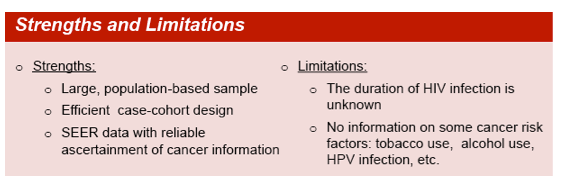 |
 |
 |
| |
High cancer risk among the HIV-infected elderly in the United States
|
| |
| |
Reported by Jules Levin
CROI 2015 Feb 23-26, Seattle, WA
Elizabeth L. Yanik1, Hormuzd A. Katki1, Eric A. Engels1
1National Cancer Institute, Division of Cancer Epidemiology and Genetics

Program abstract:
High Cancer Risk Among the HIV-Infected Elderly in the United States
Primary Author:
Elizabeth Yanik1, Hormuzd Katki1, Eric Engels1
1 Division of Cancer Epidemiology and Genetics, National Cancer Institute (NCI), Rockville, Maryland, United States
Abstract Body:
Background: HIV-infected people have higher risk of many cancers compared to HIV-uninfected people, but it is unclear if the magnitude of this elevated risk is consistent across age groups. As the proportion of HIV-infected people over age 65 is increasing over time and the elderly population is known to have high cancer risk, it is important to understand the relationship between HIV and cancer in this age group.
Methods: We conducted a case-cohort study that included a 5% sample of Medicare enrollees and all cancer cases ≥65 years of age identified through the Surveillance, Epidemiology, and End Results cancer registries. Non-melanoma skin cancers were not captured. HIV infection was defined through Medicare diagnosis claims. Weighted Cox regression was used to estimate associations between HIV and cancer incidence adjusting for age, race, sex, and calendar year. The absolute risk of cancer over time was calculated accounting for the competing risk of death.
Results: Among 469,954 people in the 5% Medicare sample, 0.08% had an HIV diagnosis. In total, 835,450 cancer cases were identified in cancer registries. Among HIV-infected people, lung and prostate cancers were most common (N=111 each), followed by non-Hodgkin lymphoma (NHL) (N=57). HIV was strongly associated with incidence of Kaposi sarcoma, anal cancer and Hodgkin lymphoma (hazard ratios of 104, 30, and 12, respectively, Table 1). HIV was also associated with incidence of liver cancer, NHL, and lung cancer, but elevations in risk were lower (hazard ratios of 5, 3 and 2, respectively). Among NHL subtypes, HIV was associated with diffuse large B-cell lymphoma and Burkitt lymphoma, but no association was found with other specified NHL subtypes (which comprised 60% of cases in uninfected people). HIV was associated with lower prostate cancer incidence. Over a 1-year period, 2.5% of the HIV-infected elderly were diagnosed with cancer; by 5 years, this proportion increased to 10.2%.
Conclusions: HIV infection in the elderly is associated with higher risk for many cancers identified as HIV-associated in younger populations. The relative elevation in NHL incidence is notably lower, but this reflects the high frequency in elderly adults of NHL subtypes less strongly associated with HIV. Given the increased risk associated with both aging and HIV, the elderly HIV-infected population has a sizeable absolute risk of cancer, highlighting the need for cancer prevention and screening efforts in this group.







|
| |
|
 |
 |
|
|